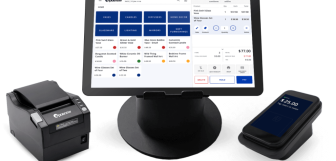MPOS: What Is a Mobile Point Of Sale? Learn The Definition
ou've likely heard of a point of sale system, but have you ever wondered about its mobile cousin?
That's right, we're talking about the mobile point of sale (mPOS) system, a handy little device that brings the convenience of payment processing to your fingertips, quite literally.
This guide's going to run you through everything you need to know about the mPOS solution, from what it is to its pros and cons.
Let's get started.
What is MPOS?
First up, MPOS meaning. Mobile point of sale (or mPOS for short) is a handheld device or wireless pos system that connects to your wireless network. It's also sometimes referred to as a tablet POS or iPad POS FYI!
Unlike traditional POS systems, which are fixed, mPOS systems are portable and flexible, allowing you to take payments from your customers anywhere (we're talking in-store or even on the go).
The mobile computer does a lot on its own to help your business run smoothly. But with a payment reader, you can take payments anywhere, anytime. This includes debit, credit, customer loyalty, gift cards, and NFC payments. Mobile point of sale lets both small businesses and larger businesses easily accept payments using a mobile device like a computer or tablet.
Advantages of a mobile POS
No one wants to lose a sale because they can't process a payment. With mPOS, you can meet your customers wherever they are and bring your business to them. Here's some of the benefits:
-
Easy installation: Just download an app on your phone or tablet, set it up quickly, and connect it to your business bank accounts and you're ready to go in minutes.
-
Auto backups: During busy times, it can be tricky to keep track of every sale you make. A mobile POS system for small business owners records all the important info at the time of purchase. That means no more searching for slips or handwritten notes. Everything's autosaved and backed up.
-
Scalable: As your company grows, your mPOS solution can grow with it. For instance, you can add more tablets at busy counters or new employees to your system with ease. This flexibility helps you manage increased demand smoothly.
-
Portability: Handheld POS systems are lightweight and designed for on-the-go use. You'll always be able to accept payments, no matter where you are, ensuring you never miss a sale.
-
Speed: A lot of modern mPOS technology speeds up transactions. This reduces wait times for your customers. Plus, faster checkouts mean fewer lost sales due to long lines or high demand. That will result in a better customer experience which boosts customer loyalty.
-
Low cost: Finally, Starting with a basic mobile payment service can be pretty budget-friendly. You can use existing technology (like a smartphone app, for example) without needing new hardware.
Drawbacks of a mobile POS system
There are, however, some things to think about before choosing a mobile POS system, such as:
-
Durability: Mobile POS devices may not be as rugged as traditional POS systems, so they could be more prone to wear and tear.
-
Battery life: Since mobile POS hardware systems rely on batteries, you'll need to make sure you're keeping it juiced and charging it often to avoid any interruptions during your busy business day.
-
Internet reliance: They need a stable internet connection for POS transactions, so fluctuations or loss of connection can impact operations.
How does a mobile point of sale work?
You now have a pretty good understanding of what mPOS systems are. But how does an mPOS work? Well, it uses Wi-Fi or cellular data to process payments. Let's break it down:
-
Setup: First, you download the mPOS software on your smartphones or tablets. Then, you link card machines to your devices. It's quick and easy.
-
Payment processing: When a customer is ready to pay, you use an mPOS terminal. Customers can pay using tons of different methods, including, cash, credit cards, or digital wallets like Apple Pay or Apple point of sale, Android pos payments and Samsung Pay. The mPOS systems use Wi-Fi or cellular data to process these payments securely.
-
Digital wallets and NFC: For digital wallet payments made on customer's mobile phones, mPOS systems use near field communication (NFC) technology. This allows customers to pay by simply tapping their phone on the card reader. It's fast and convenient.
Put simply, a mobile POS system makes taking payments easy and flexible, whether you're in a store, at a market, or on the go.
How payment processing integrates with a POS mobile device for simplicity
Payment processing seamlessly integrates with a POS mobile device to simplify transactions and enhance customer service. Whether you're using a smartphone or tablet-based system, the process is straightforward and efficient. Customers can pay using various methods such as credit cards, debit cards, or digital wallets like Apple Pay and Google Pay, directly through the device.
Process any transaction with Epos Now’s payment terminals
Epos Now’s payment terminals (or mobile payment terminal or payment device) are super easy to use for handling all kinds of payments:
-
Pay your way: You can pay with any major credit or debit card—tap, insert, or even Pay by Link.
-
One system for everything: These POS terminals work seamlessly with Epos Now’s POS software. So, you manage payments and run your business smoothly from one place, saving you time and hassle.
-
Stay connected anywhere: Our terminals connect through 3G, 4G, or WiFi, so you’re always connected. No matter if you’re in your store or out and about, transactions are fast and secure.
-
Quick and simple: The touch screen is easy to use. This makes transactions fast for both you and your customers.
-
See how you’re doing: Every transaction is automatically recorded, giving you detailed and functional reports that show how your business is doing.
Discover what’s possible with the Air card reader
Take payments from your pocket with the lightweight, portable card payment solution.
How to choose the best mobile POS for your business
Choosing the best mobile POS system takes some thought and planning. Here’s how to do it:
-
Step 1 Figure out your needs: First things first, what do you need this POS system to do? Are you zipping around with a food truck, needing something lightweight and mobile? Or maybe you run a cozy shop and want a system that can grow with you? Think about how many sales you handle daily and what features are must-haves, like taking payments right from your smartphone.
-
Step 2 Look for the right stuff: When you're on the hunt for the perfect mobile POS system, make sure it’s user-friendly so your team can pick it up fast. You'll also want something that can handle more sales and staff as your business grows. Plus, good inventory and reporting tools are key—they help you track what’s selling and keep customers happy.
-
Step 3 Do your homework: Now, it’s time to look into the options out there. Check out different POS systems, see what they cost, and read what others in your industry say about them.
-
Step 4: Try before you buy: Be sure not to skip the demo phase! Most good POS providers offer a trial run. This will let you see how the system works in action. Can you navigate it easily? Does it do everything you need it to? These are the things you want to know before you sign on that dotted line.
-
Step 5: Pick the winner: After you’ve tested a few options, think about what each one brings to the table. Go with the system that ticks all your boxes.
-
Step 6: Count the costs: Beyond just the price tag, think about the total cost of owning and running it. We're talking setup, ongoing fees. Make sure you know what you’re getting into financially.
-
Step 7: Seal the deal: Once you’ve done everything listed above, and thought through everything, it's time to make your choice. Pick the mobile POS system that feels right for your business now and down the road. It’s all about finding the right tool to help your business thrive.
Common questions about mobile point of sale solutions
- What is the difference between POS and MPOS?
-
A POS system is usually fixed, like a cash register you find at a store counter. Then you've got your mPOS systems. These are portable and work on devices like smartphones or tablets. This means you can take payments anywhere (from the sales floor to external pop up events), not just at a specific spot in your store.
- What is the function of MPOS?
-
The function of an mPOS is to process payments. It lets you accept cash, credit cards, and digital wallet payments. You can use it on the go, making it easy to take payments from customers anywhere.
- How do mPOS sell their products?
-
mPOS systems sell themselves by offering apps and card readers. You download the app on your phone or tablet, set it up, and connect the card reader. This setup lets you start accepting payments quickly and easily.
- How does an mPOS device process payments?
-
An mPOS device connects to a smartphone or tablet via Bluetooth or another wireless connection. It allows businesses to accept payments by magnetic stripe cards, chip cards, and contactless methods. Paired with an app POS, it offers mobility and flexibility, making transactions quick and efficient.
- Is an mPOS system secure for transactions?
-
Yes! Modern POS devices use encryption and tokenization to protect customer data. This ensures that transactions remain secure, eliminating risks associated with traditional card readers. Plus, most mPOS devices follow strict PCI compliance standards to maintain security.
- Can an mPOS system integrate with my website?
-
Absolutely! Many app POS solutions allow businesses to sync sales data across in-store and online transactions. This integration improves order management, streamlines inventory tracking, and enhances the ability to serve customers efficiently—whether they're shopping online or in person.




